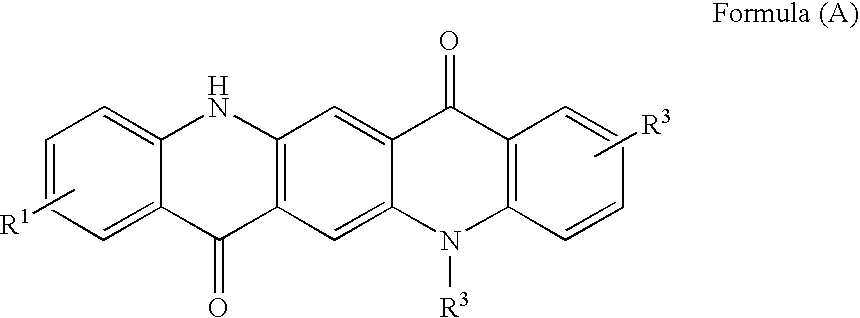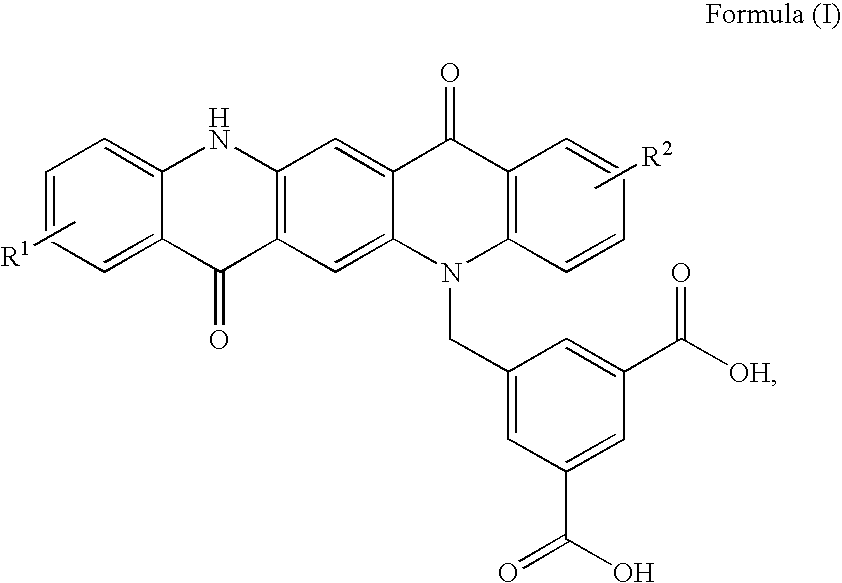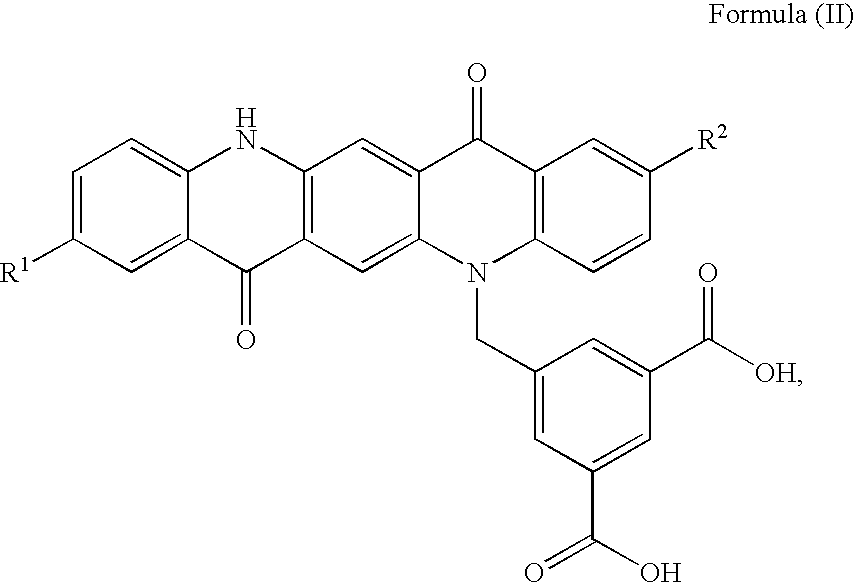Non-Aqueous Inkjet Inks of Quinacridone Pigments
a quinacridone pigment and inkjet ink technology, which is applied in the field of non-aqueous inkjet inks, can solve the problems of reducing the dispersion energy required, affecting the thermal stability of submicron particles, and affecting the quality of inkjet inks, so as to achieve high dispersion quality and stability.
- Summary
- Abstract
- Description
- Claims
- Application Information
AI Technical Summary
Benefits of technology
Problems solved by technology
Method used
Image
Examples
example 1
[0259]This example illustrates the synthesis of quinacridone derivatives comprising at least one acid group.
Synthesis of Quinacridone Derivative QAD-1
[0260]The quinacridone derivative QAD-1 is represented by the formula:
[0261]Synthesis of the dispersion synergist QAD-1 was accomplished according to the following synthesis scheme:
31.2 g (0.1 mol) of the pigment PV19 in 500 mL dimethylsulfoxide was dissolved by addition of 22.44 g (0.2 mol) of potassium tert-butoxide. The blue solution was heated to about 70° C. and 22.8 g (0.1 mol) of methyl-4-(bromomethyl)benzoate was added. The mixture was cooled to room temperature after 2 hours and the compound QA-1 was precipitated, filtered and washed with methanol. The yield was 77%.
Formation of the dispersion synergist QAD-1 was accomplished by hydrolyzation of QA-1. This reaction took place during a reflux of 46 g (0.1 mol) of compound QA-1 in a mixture of ethanol and 50 mL (0.5 mol) of 29% sodium hydroxide solution. After 1 hour the mixture...
example 2
[0270]This example illustrates that non-aqueous inkjet inks improved for dispersion stability can be prepared from quinacridone pigments comprising monomethyl quinacridone in the presence of a dispersion synergist comprising at least one acid group.
Preparation and Evaluation of Inkjet Inks
[0271]All inkjet inks were prepared in the same manner to obtain a composition as described in Table 3, except that different pigments and dispersion synergists were used. In some examples, the dispersion synergist was absent and replaced by extra pigment.
TABLE 3wt % ofCOMP-COMP-COMP-COMP-INV-INV-component123412PR1225.00—4.50———PR282—5.00—4.504.504.50QAD-2————0.50—QAD-3——0.50——0.50SYN-1———0.50——Solsperse ™5.005.005.005.005.005.0032000DEGDEE90.0090.0090.0090.0090.0090.00
[0272]An ink composition was made by mixing the pigment, the polymeric dispersant Solsperse™ 32000, optionally the dispersion synergist and the organic solvent DEGDEE with a dissolver and subsequently treating this mixture with a rol...
PUM
| Property | Measurement | Unit |
|---|---|---|
| wt % | aaaaa | aaaaa |
| temperatures | aaaaa | aaaaa |
| solubility | aaaaa | aaaaa |
Abstract
Description
Claims
Application Information
 Login to View More
Login to View More - R&D
- Intellectual Property
- Life Sciences
- Materials
- Tech Scout
- Unparalleled Data Quality
- Higher Quality Content
- 60% Fewer Hallucinations
Browse by: Latest US Patents, China's latest patents, Technical Efficacy Thesaurus, Application Domain, Technology Topic, Popular Technical Reports.
© 2025 PatSnap. All rights reserved.Legal|Privacy policy|Modern Slavery Act Transparency Statement|Sitemap|About US| Contact US: help@patsnap.com



